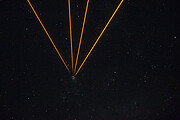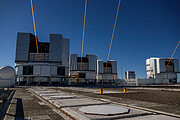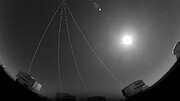Komunikat prasowy
Próba laserowa rozpoczyna nową erę interferometrii
10 listopada 2025
W ubiegłym tygodniu, cztery lasery zostały skierowane w niebo nad lokalizacją Paranal w Chile, należącą do Europejskiego Obserwatorium Południowego (ESO). Każdy z laserów jest używany do wytworzenia sztucznej gwiazdy, którą astronomowie wykorzystują do mierzenia i korygowania rozmycia spowodowanego atmosferą Ziemi. Niesamowite uruchomienie tych laserów, po jednym z każdego z ośmiometrowych teleskopów w Paranal, jest znaczącym etapem w projekcie GRAVITY+ — dużą i kompleksową modernizacją Interferometru Bardzo Dużego Teleskopu (VLTI). GRAVITY+ odblokuje olbrzymią moc obserwacyjną i znacznie poszerzy zakres pokrycia nieba przez VLTI w stosunku do tego co było możliwe wcześniej.
To niezwykle ważny krok dla przyrządu, który jest zupełnie unikatowy na świecie, mówi Antoine Mérand, astronom ESO, VLTI Programme Scientist.
VLTI łączy światło z kilku pojedynczych teleskopów VLT (czterech ośmiometrowych Teleskopów Głównych lub czterech mniejszych Teleskopów Pomocniczych) przy pomocy interferometrii. GRAVITY+ jest modernizacją VLTI skupioną na GRAVITY, bardzo udanym instrumencie VLTI, używanym do obrazowania planet pozasłonecznych, obserwacji bliskich i dalekich gwiazd oraz wykonywania szczegółowych obserwacji słabych obiektów krążących wokół supermasywnej czarnej dziury w Drodze Mlecznej. GRAVITY+ obejmuje także infrastrukturalne zmiany w teleskopach i modernizację podziemnych tuneli VLTI, w których promienie światła są łączone razem. Instalacja lasera na każdym z Teleskopów Głównych (nie wszystkie posiadały wcześniej takie wsparcie), to kluczowe osiągnięcie w tym długoterminowym projekcie, transformujące VLTI w najpotężniejszy interferometr optyczny na świecie.
VLTI razem z GRAVITY już umożliwiły wiele nieprzewidzianych odkryć, nie możemy się doczekać, co zobaczymy, gdy GRAVITY+ przesunie granice jeszcze dalej, mówi Frank Eisenhauer, kierownik naukowy GRAVITY+, pracujący w Max-Planck Institute for Extraterrestrial Physics (MPE) w Niemczech, który kieruje konsorcjum prowadzącym modernizacje. [1]
Seria modernizacji trwa od kilku lat i obejmuje ulepszoną technologię optyki adaptacyjnej – systemu do korygowania rozmycia spowodowanego atmosferą Ziemi – przy pomocy najnowocześniejszych czujników i deformowalnych zwierciadeł. Dotąd korekcje optyki adaptacyjnej dla VLTI były wykonywane poprzez celowanie na jasną gwiazdę odniesienia, która musiała znajdować się blisko obiektu obserwacji, co ograniczało liczbę obiektów, które możliwych do obserwacji. Dzięki instalacji lasera na każdym z Teleskopów Głównych, jasna sztuczna gwiazda utworzona 90 km nad powierzchnią Ziemi pozwoli na korygowanie rozmycia atmosferycznego w dowolnym punkcie na niebie. Odblokowuje to całe niebo południowe dla VLTI i znacznie zwiększa jego moc obserwacyjną.
Otwiera to instrument na obserwacje obiektów we wczesnym (odległym) Wszechświecie, takich jak kwazar, który obserwowaliśmy drugiej nocy po tym, w którym rozdzieliliśmy gorący, emitujący tlen gazowy, bardzo blisko czarnej dziury, mówi Taro Shimizu, astronom MPE, który jest członkiem konsorcjum instrumentu. Z laserami na każdym z teleskopów, używanych prze VLTI, astronomowie będą w stanie badać odległe galaktyki aktywne I bezpośrednio mierzyć masę supermasywnych czarnych dziur, które je zasilają, a także obserwować młode gwiazdy i dyski wokół nich, w których tworzą się planety.
Ulepszone możliwości VLTI drastycznie zwiększą ilość światła, która dociera przez system, czyniąc instrument 10 razy bardziej czułym. Wielkim celem GRAVITY+ jest umożliwienie głębokich obserwacji słabych obiektów, wyjaśnia Julien Woillez, astronom ESO i naukowiec projektu GRAVITY+. Te zwiększone możliwości wykrywania słabszych obiektów pozwolą na obserwacje izolowanych gwiazdowych czarnych dziur, planet swobodnych, które nie krążą wokół gwiazdy macierzystej, a także gwiazd najbliżej supermasywnej czarnej dziury Sgr A* w Drodze Mlecznej.
Pierwszym celem dla GRAVITY+ i zespołów ESO w Paranal, wykonujących obserwacje testowe z pomocą nowych laserów, była gromada masywnych gwiazd w centrum Mgławicy Tarantula, obszar gwiazdotwórczy w sąsiedniej galaktyce - Wielkim Obłoku Magellana. Obserwacje te pokazały, że jasny obiekt w mgławicy, uważany za ekstremalnie masywną gwiazdę, jest w rzeczywistości układem dwóch gwiazd blisko siebie. Pokazuje to oszałamiające możliwości i potencjał naukowy zmodernizowanego VLTI.
Przeprowadzone ulepszenie to coś więcej niż zwykła aktualizacja, pomyślano o nim kilkadziesiąt lat temu. System laserowy zasugerowano w raporcie końcowym pt. “Very Large Telescope Project” w 1986 roku, zanim VLTI zaczął istnieć. Jeżeli to zadziała w praktyce, będzie przełomowe, wskazał raport. Teraz ten przełom stał się rzeczywistością.
Uwagi
[1] W konsorcjum GRAVITY+ są następujący partnerzy:
- Max Planck Institute for Extraterrestrial Physics (MPE); Max Planck Institute for Astronomy; University of Cologne (Niemcy)
- Institut National des Sciences de l'Univers, French National Centre for Scientific Research; Institut de Planétologie et d'Astrophysique de Grenoble;
- Laboratoire d’instrumentation et de recherche en astrophysique (LIRA); Lagrange Laboratory; Centre de Recherche Astrophysique de Lyon (Francja)
- Instituto Superior Técnico’s Centre for Astrophysics and Gravitation (CENTRA); University of Lisbon; University of Porto (Portugalia)
- University of Southampton (Wielka Brytania)
- Katholieke Universiteit Leuven (Belgia)
- University College Dublin (Irlandia)
- Instituto de Astronomia – Universidad Nacional Autónoma de México (Meksyk)
- European Southern Observatory.
Więcej informacji
GRAVITY+ Co-Investigators: Frank Eisenhauer (PI; MPE, Niemcy), Paulo Garcia (Faculdade de Engenharia, Universidade do Porto and CENTRA research unit, Portugalia), Sebastian Hönig (University of Southampton, Wielka Brytania), Laura Kreidberg (Max Planck Institute for Astronomy, Niemcy), Jean-Baptiste Le Bouquin (Institut de Planétologie et d'Astrophysique de Grenoble, Université Grenoble Alpes, Francja), Thibaut Paumard (LIRA, Observatoire de Paris, Francja), Christian Straubmeier (University of Cologne, Niemcy).
W ESO, modernizacją GRAVITY+ kierują: Frederic Gonte (Project Manager), Julien Woillez (Project Scientist), Sylvain Oberti (Project Engineer) oraz Luis Esteras Otal (VLTI Systems Engineer).
Obserwatorium Paranal w Chile est obecnie zagrożone przez planowany projekt INNA, który ma być zlokalizowany zaledwie 11 kilometrów od VLTI. Szczególnie niepokojącym wpływem od INNA są mikrodrgania, ponieważ spowodują, że łączenie światła w tunlach VLTI będzie znacznie większym wyzwniem. Przeprowadzone wczesniej w tym roku szczegółowe analizy techniczne pokazały, że turbiny wiatrowe INNA mogą wytworzyć wzrost wibracji gruntu na tyle duży, że zniweczy działanie VLTI. Zmiana lokalizacji projektów, takich jak INNA, z obszarów otaczających Paranal, jest kluczowa dla działania światowej klasy przyrządów astronomicznych na maksimum swoich możliwości, a także dla ochrony prawdziwie wyjątkowego dziewiczego ciemnnego nieba i innych warunków, które czynią placówkę liderem światowej astronomii.
Europejskie Obserwatorium Południowe (ESO) umożliwia naukowcom z całego świata na odkrywanie tajemnic Wszechświata z korzyścią dla nas wszystkich. Projektujemy, budujemy i zarządzamy światowej klasy obserwatoriami naziemnymi – których astronomowie używają do odpowiadania na ciekawe pytania i szerzenia fascynacji astronomią – a także promujemy międzynarodową współpracę w astronomii. Ustanowione w 1962 roku jako organizacja międzynarodowa, ESO jest wspierane przez 16 krajów członkowskich (Austria, Belgia, Czechy, Dania, Finlandia, Francja, Hiszpania, Irlandia, Holandia, Niemcy, Polska, Portugalia, Szwajcaria, Szwecja, Wielka Brytania oraz Włochy), a także Chile jako kraj gospodarz, oraz Australię jako strategicznego partnera. Siedziba ESO, a także jego centrum popularyzacji nauki i planetarium (ESO Supernova) znajdują się w pobliżu Monachium w Niemczech, natomiast chilijska pustynia Atakama – niesamowite miejsce z wyjątkowymi warunkami do obserwacji nieba – jest domem dla naszych teleskopów. ESO zarządza trzema lokalizacjami obserwacyjnymi w Chile: La Silla, Paranal i Chajnantor. W Paranal ESO posiada teleskop VLT (Very Large Telescope – Bardzo Duży Teleskop) oraz dwa teleskopy do przeglądów nieba. VISTA pracuje w podczerwieni, VLT Survey Telescope w zakresie widzialnym. W Paranal ESO zarządza także południowym obserwatorium CTA (Cherenkov Telescope Array South) – największym na świecie i najbardziej czułym obserwatorium promieniowania gamma. Wspólnie z międzynarodowymi partnerami ESO zarządza także radioteleskopami APEX i ALMA, które są instrumentami do obserwacji nieba w zakresach milimetrowym i submilimetrowym. Na Cerro Armazones, niedaleko Paranal, budujemy „największe oko świata na niebo”, czyli Ekstremalnie Wielki Teleskop (Extremely Large Telescope, ELT). Nasza działalność w Chile jest zarządzana z biur ESO w Santiago, gdzie współpracujemy też z chilijskimi partnerami.
Linki
- Zdjęcia VLT/I
- Blog ESO na temat GRAVITY+
- Strona ESO o GRAVITY+
- Strona MPE o GRAVITY+
- Dla dziennikarzy: zasubskrybuj, aby otrzymywać w swoim języku nasze komunikaty prasowe z embargo medialnym
- Dla naukowców: jesli masz ciekawy temat, zgłoś swoje badania
- Nowe analizy ESO potwierdzają poważne szkody od kompleksu przemysłowego planowanego w pobliżu Paranal
Kontakt
Frank Eisenhauer
Max Planck Institute for Extraterrestrial Physics
Garching bei München, Germany
Tel.: +49 89 30000 3100
E-mail: eisenhau@mpe.mpg.de
Taro Shimizu
Max Planck Institute for Extraterrestrial Physics
Garching bei München, Germany
Tel.: +49 89 30000 3392
E-mail: shimizu@mpe.mpg.de
Jean-Baptiste Le Bouquin
Institut National des Sciences de l’Univers, CNRS
Grenoble, France
Tel.: +33 4 76 14 36 82
E-mail: jean-baptiste.lebouquin@univ-grenoble-alpes.fr
Antoine Mérand
European Southern Observatory
Garching bei München, Germany
Tel.: +49 89 3200 6630
E-mail: amerand@eso.org
Julien Woillez
European Southern Observatory
Garching bei München, Germany
Tel.: +49 89 3200 6273
E-mail: jwoillez@eso.org
Bárbara Ferreira
ESO Media Manager
Garching bei München, Germany
Tel.: +49 89 3200 6670
Tel. kom.: +49 151 241 664 00
E-mail: press@eso.org
Krzysztof Czart (Kontakt dla mediów Polska)
Sieć Popularyzacji Nauki ESO
oraz Urania - Postępy Astronomii
Toruń, Polska
Tel.: +48 513 733 282
E-mail: eson-poland@eso.org
O komunikacie
| Komunikat nr: | eso2519pl |
| Nazwa: | GRAVITY |
| Typ: | Unspecified : Technology : Observatory |
| Facility: | Very Large Telescope Interferometer |
| Instrumenty: | GRAVITY |
Our use of Cookies
We use cookies that are essential for accessing our websites and using our services. We also use cookies to analyse, measure and improve our websites’ performance, to enable content sharing via social media and to display media content hosted on third-party platforms.
ESO Cookies Policy
The European Organisation for Astronomical Research in the Southern Hemisphere (ESO) is the pre-eminent intergovernmental science and technology organisation in astronomy. It carries out an ambitious programme focused on the design, construction and operation of powerful ground-based observing facilities for astronomy.
This Cookies Policy is intended to provide clarity by outlining the cookies used on the ESO public websites, their functions, the options you have for controlling them, and the ways you can contact us for additional details.
What are cookies?
Cookies are small pieces of data stored on your device by websites you visit. They serve various purposes, such as remembering login credentials and preferences and enhance your browsing experience.
Categories of cookies we use
Essential cookies (always active): These cookies are strictly necessary for the proper functioning of our website. Without these cookies, the website cannot operate correctly, and certain services, such as logging in or accessing secure areas, may not be available; because they are essential for the website’s operation, they cannot be disabled.
Functional Cookies: These cookies enhance your browsing experience by enabling additional features and personalization, such as remembering your preferences and settings. While not strictly necessary for the website to function, they improve usability and convenience; these cookies are only placed if you provide your consent.
Analytics cookies: These cookies collect information about how visitors interact with our website, such as which pages are visited most often and how users navigate the site. This data helps us improve website performance, optimize content, and enhance the user experience; these cookies are only placed if you provide your consent. We use the following analytics cookies.
Matomo Cookies:
This website uses Matomo (formerly Piwik), an open source software which enables the statistical analysis of website visits. Matomo uses cookies (text files) which are saved on your computer and which allow us to analyze how you use our website. The website user information generated by the cookies will only be saved on the servers of our IT Department. We use this information to analyze www.eso.org visits and to prepare reports on website activities. These data will not be disclosed to third parties.
On behalf of ESO, Matomo will use this information for the purpose of evaluating your use of the website, compiling reports on website activity and providing other services relating to website activity and internet usage.
Matomo cookies settings:
Additional Third-party cookies on ESO websites: some of our pages display content from external providers, e.g. YouTube.
Such third-party services are outside of ESO control and may, at any time, change their terms of service, use of cookies, etc.
YouTube: Some videos on the ESO website are embedded from ESO’s official YouTube channel. We have enabled YouTube’s privacy-enhanced mode, meaning that no cookies are set unless the user actively clicks on the video to play it. Additionally, in this mode, YouTube does not store any personally identifiable cookie data for embedded video playbacks. For more details, please refer to YouTube’s embedding videos information page.
Cookies can also be classified based on the following elements.
Regarding the domain, there are:
- First-party cookies, set by the website you are currently visiting. They are stored by the same domain that you are browsing and are used to enhance your experience on that site;
- Third-party cookies, set by a domain other than the one you are currently visiting.
As for their duration, cookies can be:
- Browser-session cookies, which are deleted when the user closes the browser;
- Stored cookies, which stay on the user's device for a predetermined period of time.
How to manage cookies
Cookie settings: You can modify your cookie choices for the ESO webpages at any time by clicking on the link Cookie settings at the bottom of any page.
In your browser: If you wish to delete cookies or instruct your browser to delete or block cookies by default, please visit the help pages of your browser:
Please be aware that if you delete or decline cookies, certain functionalities of our website may be not be available and your browsing experience may be affected.
You can set most browsers to prevent any cookies being placed on your device, but you may then have to manually adjust some preferences every time you visit a site/page. And some services and functionalities may not work properly at all (e.g. profile logging-in, shop check out).
Updates to the ESO Cookies Policy
The ESO Cookies Policy may be subject to future updates, which will be made available on this page.
Additional information
For any queries related to cookies, please contact: pdprATesoDOTorg.
As ESO public webpages are managed by our Department of Communication, your questions will be dealt with the support of the said Department.









